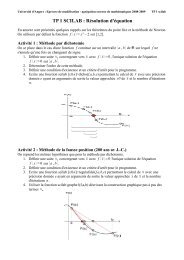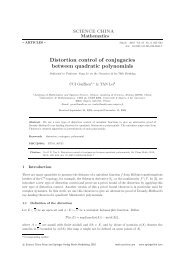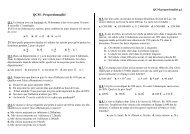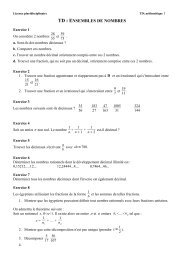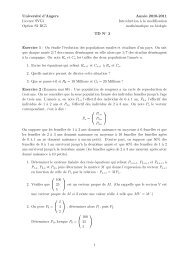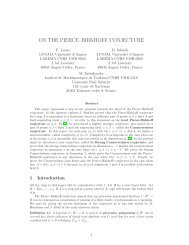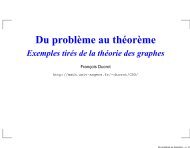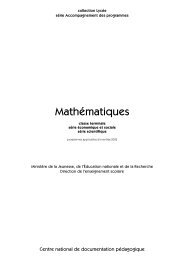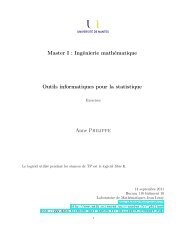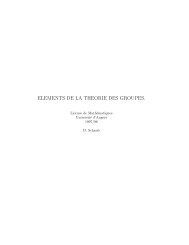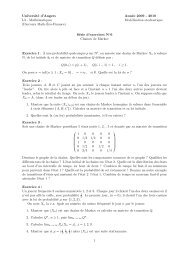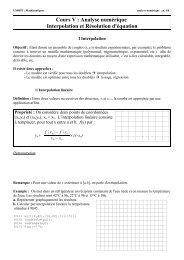automorphisms of real rational surfaces and weighted blow-up ...
automorphisms of real rational surfaces and weighted blow-up ...
automorphisms of real rational surfaces and weighted blow-up ...
You also want an ePaper? Increase the reach of your titles
YUMPU automatically turns print PDFs into web optimized ePapers that Google loves.
AUTOMORPHISMS OF REAL RATIONAL SURFACES AND<br />
WEIGHTED BLOW-UP SINGULARITIES<br />
JOHANNES HUISMAN AND FRÉDÉRIC MANGOLTE<br />
Abstract. Let X be a singular <strong>real</strong> <strong>rational</strong> surface obtained from a<br />
smooth <strong>real</strong> <strong>rational</strong> surface by performing <strong>weighted</strong> <strong>blow</strong>-<strong>up</strong>s. Denote<br />
by Aut(X) the gro<strong>up</strong> <strong>of</strong> algebraic <strong>automorphisms</strong> <strong>of</strong> X into itself. Let n<br />
be a natural integer <strong>and</strong> let e = [e1, . . . , eℓ] be a partition <strong>of</strong> n. Denote<br />
by X e the set <strong>of</strong> ℓ-t<strong>up</strong>les (P1, . . . , Pℓ) <strong>of</strong> disjoint nonsingular curvilinear<br />
subschemes <strong>of</strong> X <strong>of</strong> orders (e1, . . . , eℓ). We show that the gro<strong>up</strong> Aut(X)<br />
acts transitively on X e . This statement generalizes earlier work where<br />
the case <strong>of</strong> the trivial partition e = [1, . . . , 1] was treated under the<br />
s<strong>up</strong>plementary condition that X is nonsingular.<br />
As an application we classify singular <strong>real</strong> <strong>rational</strong> <strong>surfaces</strong> obtained<br />
from nonsingular <strong>surfaces</strong> by performing <strong>weighted</strong> <strong>blow</strong>-<strong>up</strong>s.<br />
MSC 2000: 14P25, 14E07<br />
Keywords: <strong>real</strong> algebraic surface, <strong>rational</strong> surface, <strong>weighted</strong> <strong>blow</strong><strong>up</strong><br />
singularity, algebraic automorphism, transitive action<br />
J. Huisman, Université Européenne de Bretagne, France<br />
<strong>and</strong><br />
Université de Brest; CNRS, UMR 6205<br />
Laboratoire de Mathématiques de Brest, ISSTB,<br />
6, avenue Victor Le Gorgeu, CS 93837,<br />
29238 Brest cedex 3, France.<br />
Tel. +33 2 98 01 70 03, Fax +33 2 98 01 67 90<br />
johannes.huisman@univ-brest.fr<br />
http://pageperso.univ-brest.fr/∼huisman<br />
Corresponding author: Frédéric Mangolte,<br />
Laboratoire de Mathématiques, Université de Savoie,<br />
73376 Le Bourget du Lac Cedex, France.<br />
Tel.: +33 (0)4 79 75 86 60, Fax: +33 (0)4 79 75 81 42<br />
mangolte@univ-savoie.fr<br />
http://www.lama.univ-savoie.fr/∼mangolte<br />
1
WEIGHTED BLOW-UP SINGULARITIES ON REAL RATIONAL SURFACES 2<br />
1. Introduction<br />
Let X be a nonsingular compact connected <strong>real</strong> algebraic surface, i.e. X<br />
is a nonsingular compact connected <strong>real</strong> algebraic subset <strong>of</strong> some R m <strong>of</strong><br />
dimension 2. Recall that X is <strong>rational</strong> if the field <strong>of</strong> <strong>rational</strong> functions R(X)<br />
<strong>of</strong> X is a purely transcendental field extension <strong>of</strong> R <strong>of</strong> transcendence degree 2.<br />
More geometrically, X is <strong>rational</strong> if there are nonempty Zariski open subsets<br />
U <strong>and</strong> V <strong>of</strong> R 2 <strong>and</strong> X, respectively, such that there is an isomorphism<br />
<strong>of</strong> <strong>real</strong> algebraic varieties—in the sense <strong>of</strong> [BCR98]—between U <strong>and</strong> V .<br />
Loosely speaking, X is <strong>rational</strong> if a nonempty Zariski open subset <strong>of</strong> X<br />
admits a <strong>rational</strong> parametrization by a nonempty Zariski open subset <strong>of</strong> R 2 .<br />
(The last condition only ensures that X is uni<strong>rational</strong>, a priori. However,<br />
in dimension 2, uni<strong>rational</strong>ity implies <strong>rational</strong>ity). A typical example <strong>of</strong> a<br />
<strong>rational</strong> compact <strong>real</strong> algebraic surface is the unit sphere S 2 in R 3 . A <strong>rational</strong><br />
parametrization in that case is the inverse <strong>of</strong> the stereographic projection.<br />
It has recently been shown that any <strong>rational</strong> nonsingular compact <strong>real</strong><br />
algebraic surface is isomorphic either to the <strong>real</strong> algebraic torus S 1 × S 1 ,<br />
or to a <strong>real</strong> algebraic surface obtained from the <strong>real</strong> algebraic sphere S 2 by<br />
<strong>blow</strong>ing <strong>up</strong> a finite number <strong>of</strong> distinct points [BH07] (see also [HM09] for<br />
another pro<strong>of</strong>).<br />
In the sequel, it will be convenient to identify the <strong>real</strong> algebraic surface X<br />
with the affine scheme Spec R(X), where R(X) denotes the R-algebra <strong>of</strong><br />
all algebraic—also called regular—functions on X (see [BCR98]). A <strong>real</strong>valued<br />
function f on X is algebraic if there are <strong>real</strong> polynomials p <strong>and</strong> q<br />
in x1,... ,xm such that q does not vanish on X <strong>and</strong> such that f = p/q on X.<br />
The algebra R(X) is the localization <strong>of</strong> the coordinate ring R[x1,... ,xm]/I<br />
with respect to the multiplicative system <strong>of</strong> all polynomials that do not<br />
vanish on X, where I denotes the vanishing ideal <strong>of</strong> X. It is the subring<br />
<strong>of</strong> R(X) <strong>of</strong> all <strong>rational</strong> functions on X that do not have any poles on X.<br />
A curvilinear subscheme <strong>of</strong> X is defined to be a closed subscheme P <strong>of</strong> X<br />
isomorphic to Spec R[x]/(x e ), for some nonzero natural integer e. Let P be<br />
a curvilinear subscheme <strong>of</strong> X isomorphic to SpecR[x]/(x e ). The integer e<br />
is called the length or the order <strong>of</strong> P. The reduced scheme Pred associated<br />
to P is an ordinary point <strong>of</strong> X, the s<strong>up</strong>port <strong>of</strong> P. The curvilinear subscheme<br />
P is said to be based on the point Pred.<br />
A curvilinear subscheme <strong>of</strong> length 1 is an ordinary point <strong>of</strong> X. A curvilinear<br />
subscheme <strong>of</strong> length 2 is a pair (P,L), where P is a point <strong>of</strong> X <strong>and</strong> L is a<br />
1-dimensional subspace <strong>of</strong> the tangent space TPX <strong>of</strong> X at P. Equivalently,<br />
a curvilinear subscheme P <strong>of</strong> X <strong>of</strong> length 2 is a point <strong>of</strong> the exceptional<br />
divisor <strong>of</strong> the <strong>real</strong> algebraic surface obtained by <strong>blow</strong>ing <strong>up</strong> X in an ordinary<br />
point. By induction, a curvilinear subscheme P <strong>of</strong> X <strong>of</strong> length e is<br />
a curvilinear subscheme <strong>of</strong> length e − 1 whose s<strong>up</strong>port is contained in the<br />
exceptional divisor E <strong>of</strong> the <strong>blow</strong>-<strong>up</strong> <strong>of</strong> X at the point Pred.<br />
Let P <strong>and</strong> Q be curvilinear subschemes <strong>of</strong> X. The subschemes P <strong>and</strong> Q<br />
<strong>of</strong> X are said to be disjoint if their s<strong>up</strong>ports Pred <strong>and</strong> Qred <strong>of</strong> X are disjoint.<br />
Let n be a natural integer <strong>and</strong> let e = [e1,... ,eℓ] be a partition <strong>of</strong> n<br />
<strong>of</strong> length ℓ, where ℓ is some natural integer. Denote by X e the set <strong>of</strong><br />
ℓ-t<strong>up</strong>les (P1,... ,Pℓ) <strong>of</strong> disjoint curvilinear subschemes P1,... ,Pℓ <strong>of</strong> X <strong>of</strong><br />
orders e1,... ,eℓ, respectively.
WEIGHTED BLOW-UP SINGULARITIES ON REAL RATIONAL SURFACES 3<br />
Recall that an algebraic automorphism <strong>of</strong> X is a bijective map f from X<br />
into itself such that all coordinate functions <strong>of</strong> f <strong>and</strong> f −1 are algebraic<br />
functions on X (see [HM09]). Denote by Aut(X) the gro<strong>up</strong> <strong>of</strong> algebraic<br />
<strong>automorphisms</strong> <strong>of</strong> X into itself. Equivalently, Aut(X) is the gro<strong>up</strong> <strong>of</strong> Ralgebra<br />
<strong>automorphisms</strong> <strong>of</strong> R(X). One has a natural action <strong>of</strong> Aut(X) on X e .<br />
One <strong>of</strong> the main results <strong>of</strong> the paper is the following statement.<br />
Theorem 1.1. Let X be a nonsingular <strong>rational</strong> compact <strong>real</strong> algebraic surface.<br />
Let n be a natural integer <strong>and</strong> let e = [e1,... ,eℓ] be a partition <strong>of</strong> n <strong>of</strong><br />
length ℓ, for some natural integer ℓ. Then the gro<strong>up</strong> Aut(X) acts transitively<br />
on X e .<br />
Roughly speaking, Theorem 1.1 states that the gro<strong>up</strong> Aut(X) acts ℓtransitively<br />
on curvilinear subschemes <strong>of</strong> X, for any ℓ. The statement generalizes<br />
earlier work where ℓ-transitivity was proved for ordinary points only,<br />
i.e., in the case <strong>of</strong> the trivial partition e = [1,... ,1] (cf. [HM09, Theorem<br />
1.4]).<br />
Theorem 1.1 shows that nonsingular <strong>rational</strong> compact <strong>real</strong> algebraic <strong>surfaces</strong><br />
have much more <strong>automorphisms</strong> than one would expect from [HM09,<br />
Theorem 1.4]. It led us to the following question.<br />
Question 1.2. Let X be a nonsingular <strong>rational</strong> compact <strong>real</strong> algebraic surface.<br />
Is the subset Aut(X) <strong>of</strong> algebraic <strong>automorphisms</strong> <strong>of</strong> X dense in the<br />
set Diff(X) <strong>of</strong> all diffeomorphisms <strong>of</strong> X? Equivalently, can any diffeomorphism<br />
<strong>of</strong> X be approximated by algebraic <strong>automorphisms</strong>?<br />
This question has now been answered affirmatively [KM09].<br />
The problem <strong>of</strong> approximating smooth maps between <strong>real</strong> algebraic varieties<br />
by algebraic maps has been studied by numerous authors, see e.g.<br />
[BK87a, BK87b, BKS97, Ku99, JK03, JM04, Ma06].<br />
It should be noted that Theorem 1.1 does not seem to follow from the<br />
known n-transitivity <strong>of</strong> Aut(X) on ordinary points. The difficulty is that if<br />
two n-t<strong>up</strong>les P <strong>and</strong> Q <strong>of</strong> ordinary distinct points <strong>of</strong> X tend to two ℓ-t<strong>up</strong>les<br />
<strong>of</strong> mutually disjoint curvilinear subschemes with lengths e1,... ,eℓ, then the<br />
algebraic diffeomorphism mapping P to Q does not necessarily have a limit<br />
in Aut(X).<br />
Our pro<strong>of</strong> <strong>of</strong> Theorem 1.1 goes as follows. First, we show that the statement<br />
<strong>of</strong> Theorem 1.1 is valid for the <strong>real</strong> algebraic <strong>surfaces</strong> S 2 <strong>and</strong> S 1 × S 1 ,<br />
by explicit construction <strong>of</strong> algebraic <strong>automorphisms</strong> (see Theorems 3.1 <strong>and</strong><br />
2.1). This step does use the earlier work mentioned above. Then, we use<br />
the aforementioned fact that an arbitrary nonsingular <strong>rational</strong> compact <strong>real</strong><br />
algebraic surface is either isomorphic to S 1 × S 1 , or to a <strong>real</strong> algebraic surface<br />
obtained from S 2 by <strong>blow</strong>ing <strong>up</strong> a finite number <strong>of</strong> distinct ordinary<br />
points (cf. [HM09, Theorem 4.3]).<br />
Before giving an application <strong>of</strong> Theorem 1.1, we need to recall the following.<br />
Let X be any, possibly singular, <strong>real</strong> algebraic surface. The notion <strong>of</strong><br />
curvilinear subscheme carries over verbatim to such a surface. A curvilinear<br />
subscheme P <strong>of</strong> X is called nonsingular if it is based at a nonsingular point.<br />
The <strong>blow</strong>-<strong>up</strong> <strong>of</strong> X at a nonsingular curvilinear subscheme P is the <strong>blow</strong><strong>up</strong><br />
BP(X) <strong>of</strong> X at the sheaf <strong>of</strong> ideals defined by the closed subscheme P.<br />
Explicitly, if P is defined by the ideal (x e ,y) on the <strong>real</strong> affine plane R 2 , then
WEIGHTED BLOW-UP SINGULARITIES ON REAL RATIONAL SURFACES 4<br />
the <strong>blow</strong>-<strong>up</strong> <strong>of</strong> R2 at P is the <strong>real</strong> algebraic subvariety <strong>of</strong> R2 ×P1 (R) defined<br />
by the equation vxe −uy = 0, where (u : v) are homogeneous coordinates on<br />
the <strong>real</strong> projective line P1 (R). The <strong>blow</strong>-<strong>up</strong> BP(X) is also called a <strong>weighted</strong><br />
<strong>blow</strong>-<strong>up</strong>, for obvious reasons. If e = 1, the <strong>blow</strong>-<strong>up</strong> BP(X) is the ordinary<br />
<strong>blow</strong>-<strong>up</strong> <strong>of</strong> X at P. If e ≥ 2 then the <strong>blow</strong>-<strong>up</strong> BP(X) has a singular point.<br />
A local equation <strong>of</strong> the singularity is xe = uy in R3 . This is <strong>of</strong>ten called a<br />
singularity <strong>of</strong> type A − e−1<br />
(see e.g. [Ko00, Definition 2.1]).<br />
Weighted <strong>blow</strong>-<strong>up</strong>s recently turned out to have several applications in <strong>real</strong><br />
algebraic geometry (see [Ko99, Ko00, CM08, CM09]).<br />
As an application <strong>of</strong> Theorem 1.1, we study singular <strong>real</strong> <strong>rational</strong> <strong>surfaces</strong><br />
that are obtained from nonsingular ones by performing <strong>weighted</strong> <strong>blow</strong>-<strong>up</strong>s.<br />
These <strong>surfaces</strong> have horns <strong>and</strong> do have a rather develish appearance. We<br />
introduce the following terminology for the sake <strong>of</strong> brevity.<br />
Definition 1.3. A, possibly singular, <strong>rational</strong> compact <strong>real</strong> algebraic surface<br />
X is Dantesque if it is obtained from a nonsingular compact <strong>rational</strong> <strong>real</strong><br />
algebraic surface by performing finitely many successive <strong>weighted</strong> <strong>blow</strong>-<strong>up</strong>s<br />
based at nonsingular points.<br />
The first statement we prove about <strong>rational</strong> Dantesque <strong>surfaces</strong> is the<br />
following.<br />
Theorem 1.4. Let X be a <strong>rational</strong> Dantesque surface. Then<br />
• there are disjoint curvilinear subschemes P1,...,Pℓ on S 1 × S 1 such<br />
that X is isomorphic to the <strong>real</strong> algebraic surface obtained from S 1 ×<br />
S 1 by <strong>blow</strong>ing <strong>up</strong> P1,... ,Pℓ, or<br />
• there are disjoint curvilinear subschemes P1,...,Pℓ on S 2 such that X<br />
is isomorphic to the <strong>real</strong> algebraic surface obtained from S 2 by <strong>blow</strong>ing<br />
<strong>up</strong> P1,...,Pℓ.<br />
Let X be a <strong>rational</strong> Dantesque surface. Let n be a natural integer <strong>and</strong><br />
let e = [e1,... ,eℓ] be a partition <strong>of</strong> n <strong>of</strong> length ℓ, where ℓ is some natural<br />
integer. Denote by X e the set <strong>of</strong> ℓ-t<strong>up</strong>les (P1,...,Pℓ) <strong>of</strong> disjoint nonsingular<br />
curvilinear subschemes P1,... ,Pℓ <strong>of</strong> X <strong>of</strong> orders e1,... ,eℓ, respectively.<br />
Denote again by Aut(X) the gro<strong>up</strong> <strong>of</strong> algebraic <strong>automorphisms</strong> <strong>of</strong> the<br />
possibly singular <strong>real</strong> algebraic surface X. Note that the definition <strong>of</strong> algebraic<br />
automorphism <strong>of</strong> a nonsingular surface above makes perfectly sense<br />
for singular ones. One has a natural action <strong>of</strong> Aut(X) on X e .<br />
We prove the following generalization <strong>of</strong> Theorem 1.1 above.<br />
Theorem 1.5. Let X be a <strong>rational</strong> Dantesque surface. Let n be a natural<br />
integer <strong>and</strong> let e = [e1,...,eℓ] be a partition <strong>of</strong> n <strong>of</strong> length ℓ, for some<br />
natural integer ℓ. Then the gro<strong>up</strong> Aut(X) acts transitively on X e .<br />
More specifically, let (P1,... ,Pℓ) <strong>and</strong> (Q1,... ,Qℓ) be two ℓ-t<strong>up</strong>les <strong>of</strong> nonsingular<br />
curvilinear subschemes <strong>of</strong> X such that, for all i, Pi <strong>and</strong> Qi have the<br />
same order. Then, there is an algebraic automorphism f <strong>of</strong> X, such that<br />
f(Pi) = Qi, for all i.<br />
Observe that Theorem 1.5 is not an immediate consequence <strong>of</strong> Theorem<br />
1.1 because an automorphism <strong>of</strong> the minimal resolution <strong>of</strong> X does not<br />
descend, in general, to an automorphism <strong>of</strong> X. It is neither a direct byproduct<br />
<strong>of</strong> Theorem 1.1 <strong>and</strong> Theorem 1.4, since a curvilinear subscheme can
WEIGHTED BLOW-UP SINGULARITIES ON REAL RATIONAL SURFACES 5<br />
be based on an exceptional divisor <strong>of</strong> the morphism to S 2 or S 1 × S 1 given<br />
by Theorem 1.4.<br />
As an application <strong>of</strong> Theorem 1.1 <strong>and</strong> Theorem 1.4, we obtain the following<br />
classification result.<br />
Theorem 1.6. Let n be a natural integer <strong>and</strong> let e = [e1,...,eℓ] be a partition<br />
<strong>of</strong> n <strong>of</strong> length ℓ, for some natural integer ℓ. Let X <strong>and</strong> Y be two <strong>rational</strong><br />
Dantesque <strong>surfaces</strong>. Assume that each <strong>of</strong> the <strong>surfaces</strong> X <strong>and</strong> Y contains ex-<br />
actly one singularity <strong>of</strong> type A − ei<br />
for each i = 1,... ,ℓ. Then X <strong>and</strong> Y are<br />
isomorphic as <strong>real</strong> algebraic <strong>surfaces</strong> if <strong>and</strong> only if they are homeomorphic<br />
as singular topological <strong>surfaces</strong>.<br />
Theorem 1.6 generalizes to certain singular <strong>real</strong> <strong>rational</strong> <strong>surfaces</strong> an earlier<br />
classification result for nonsingular ones [BH07, Theorem 1.2] (see also [HM09,<br />
Theorem 1.5] for another pro<strong>of</strong> <strong>of</strong> the same statement).<br />
We will show by an example that the statement <strong>of</strong> Theorem 1.6 does not<br />
hold for the slightly more general class <strong>of</strong> <strong>real</strong> <strong>rational</strong> compact <strong>surfaces</strong> that<br />
contain singularities <strong>of</strong> type A − (see Example 7.1).<br />
2. Curvilinear subschemes on the torus<br />
The object <strong>of</strong> this section is to prove Theorem 1.1 in the case <strong>of</strong> the <strong>real</strong><br />
algebraic torus:<br />
Theorem 2.1. Let n be a natural integer <strong>and</strong> let e = [e1,... ,eℓ] be a partition<br />
<strong>of</strong> n <strong>of</strong> length ℓ, for some natural integer ℓ. The gro<strong>up</strong> Aut(S 1 × S 1 )<br />
acts transitively on (S 1 × S 1 ) e .<br />
The above statement is a generalization <strong>of</strong> the following statement, that<br />
we recall for future reference.<br />
Theorem 2.2 ([BH07, Theorem 1.3]). Let n be a natural integer. The gro<strong>up</strong><br />
Aut(S 1 × S 1 ) acts n-transitively on S 1 × S 1 . <br />
For the pro<strong>of</strong> <strong>of</strong> Theorem 2.1, we need several lemmas. It will turn out<br />
to be convenient to replace S 1 by the isomorphic <strong>real</strong> projective line P 1 (R).<br />
Lemma 2.3. Let p,q ∈ R[x] be <strong>real</strong> polynomials in x <strong>of</strong> the same degree.<br />
S<strong>up</strong>pose that q does not have any <strong>real</strong> roots. Define<br />
by<br />
ϕ: P 1 (R) × P 1 (R) −→ P 1 (R) × P 1 (R)<br />
ϕ(x,y) =<br />
<br />
x,y + p<br />
<br />
.<br />
q<br />
Then ϕ is an algebraic automorphism <strong>of</strong> P 1 (R) × P 1 (R) into itself.<br />
Pro<strong>of</strong>. It suffices to prove that ϕ is an algebraic map. We write ϕ in bihomogeneous<br />
coordinates:<br />
ϕ([x0 : x1],[y0 : y1]) = ([x0 : x1],[ˆq(x0,x1)y0 + ˆp(x0,x1)y1 : ˆq(x0,x1)y1]) ,<br />
where ˆp <strong>and</strong> ˆq are the homogenizations <strong>of</strong> p <strong>and</strong> q, respectively. Since q<br />
has no <strong>real</strong> zeros, the homogeneous polynomial ˆq does not vanish on P 1 (R).
WEIGHTED BLOW-UP SINGULARITIES ON REAL RATIONAL SURFACES 6<br />
Therefore, if<br />
ˆq(x0,x1)y0 + ˆp(x0,x1)y1 = 0, <strong>and</strong><br />
ˆq(x0,x1)y1 = 0<br />
then y1 = 0 <strong>and</strong> y0 = 0. It follows that ϕ is a well defined algebraic map<br />
from P 1 (R) × P 1 (R) into itself. <br />
Definition 2.4. Let P be a curvilinear subscheme <strong>of</strong> S 1 ×S 1 . We say that P<br />
is vertical if P is tangent to a vertical fiber {x} × S 1 , for some x ∈ S 1 , i.e.<br />
if the scheme-theoretic intersection P · ({x} × S 1 ) is not reduced.<br />
Lemma 2.5. Let P1,... ,Pℓ be mutually disjoint curvilinear subschemes<br />
<strong>of</strong> P 1 (R) × P 1 (R). Then there is an algebraic automorphism ϕ <strong>of</strong> P 1 (R) ×<br />
P 1 (R) such that<br />
for all i.<br />
• ϕ(Pi) is based at the point (i,0) <strong>of</strong> P 1 (R) × P 1 (R), <strong>and</strong><br />
• ϕ(Pi) is not vertical,<br />
Pro<strong>of</strong>. By Theorem 2.2, we may assume that P1,... ,Pℓ are based at the<br />
points (1,0),... ,(ℓ,0) <strong>of</strong> the <strong>real</strong> algebraic torus P 1 (R)×P 1 (R), respectively.<br />
Let vi = (ai,bi) be a tangent vector to P 1 (R)×P 1 (R) at Pi that is tangent<br />
to Pi. This means the following. If Pi is an ordinary point then vi = 0. If<br />
Pi is not an ordinary point then vi = 0 <strong>and</strong> the 0-dimensional subscheme<br />
<strong>of</strong> P 1 (R) × P 1 (R) <strong>of</strong> length 2 defined by vi is contained in the closed subscheme<br />
Pi <strong>of</strong> P 1 (R) × P 1 (R).<br />
Let p,q ∈ R[y] be <strong>real</strong> polynomials in y <strong>of</strong> the same degree such that<br />
• q does not have any <strong>real</strong> roots,<br />
• p(0) = 0, q(0) = 1, q ′ (0) = 0 <strong>and</strong><br />
• ai + bip ′ (0) = 0 whenever vi = 0.<br />
Define ϕ: P1 (R) × P1 (R) −→ P1 (R) × P1 (R) by<br />
<br />
ϕ(x,y) = x + p<br />
q ,y<br />
<br />
.<br />
According to Lemma 2.3—exchanging x <strong>and</strong> y—the map ϕ is an algebraic<br />
automorphism <strong>of</strong> P 1 (R) × P 1 (R). Since p(0) = 0, one has ϕ((i,0)) = (i,0).<br />
It follows that ϕ(Pi) is also based at (i,0).<br />
The Jacobian <strong>of</strong> ϕ at (i,0) is equal to<br />
<br />
1<br />
D (i,0)ϕ =<br />
0 1<br />
p ′ (0)q(0)−p(0)q ′ (0)<br />
q(0) 2<br />
<br />
=<br />
<br />
1 p ′ (0)<br />
0 1<br />
By construction, (D (i,0)ϕ)vi has first coordinate nonzero whenever vi = 0.<br />
Therefore, ϕ(Pi) is not vertical, for all i. <br />
Pro<strong>of</strong> <strong>of</strong> Theorem 2.1. Let P1,... ,Pℓ be mutually disjoint curvilinear subschemes<br />
<strong>of</strong> the <strong>real</strong> algebraic torus P 1 (R) × P 1 (R) <strong>of</strong> orders e1,... ,eℓ, respectively.<br />
Let Qi be the curvilinear subscheme <strong>of</strong> P 1 (R) ×P 1 (R) defined by<br />
the ideal ((x − i) ei ,y) in R(P 1 (R) × P 1 (R)). It suffices to show that there<br />
is an algebraic automorphism ϕ <strong>of</strong> P 1 (R) × P 1 (R) such that ϕ(Qi) = Pi for<br />
all i.
WEIGHTED BLOW-UP SINGULARITIES ON REAL RATIONAL SURFACES 7<br />
By Lemma 2.5, we may assume that the curvilinear subscheme Pi is based<br />
at (i,0) <strong>and</strong> that ϕ(Pi) is not vertical. It follows that Pi is defined by an<br />
ideal <strong>of</strong> the form<br />
((x − i) ei ,y − fi),<br />
where fi ∈ R[x].<br />
Let p,q ∈ R[x] be <strong>of</strong> the same degree such that<br />
• q does not have any <strong>real</strong> roots,<br />
• p = fiq modulo (x − i) ei for all i.<br />
Such polynomials abound by the Chinese Remainder Theorem.<br />
By Lemma 2.3, the polynomials p <strong>and</strong> q give rise to an algebraic auto-<br />
morphism ϕ <strong>of</strong> P 1 (R) × P 1 (R) defined by<br />
ϕ(x,y) =<br />
<br />
x,y + p<br />
<br />
.<br />
q<br />
In order to show that ϕ(Qi) = Pi for all i, we compute<br />
(ϕ −1 ) ⋆ ((x − i) ei ) = (x − i) ei<br />
<strong>and</strong><br />
(ϕ −1 ) ⋆ (y) = y − p<br />
= y − fi<br />
q<br />
modulo (x−i) ei ei . Indeed, q is invertible modulo (x−i) , <strong>and</strong> p = fiq modulo<br />
(x − i) ei , by construction <strong>of</strong> p <strong>and</strong> q. It follows that ϕ(Qi) = Pi. <br />
3. Curvilinear subschemes on the unit sphere<br />
The object <strong>of</strong> this section is to prove Theorem 1.1 in the case <strong>of</strong> the <strong>real</strong><br />
algebraic sphere S 2 :<br />
Theorem 3.1. Let n be a natural integer <strong>and</strong> let e = [e1,... ,eℓ] be a partition<br />
<strong>of</strong> n <strong>of</strong> length ℓ, for some natural integer ℓ. The gro<strong>up</strong> Aut(S 2 ) acts<br />
transitively on (S 2 ) e .<br />
The above statement is a generalization <strong>of</strong> the following statement, that<br />
we recall for future reference.<br />
Theorem 3.2 ([HM09, Theorem 2.3]). Let n be a natural integer. The<br />
gro<strong>up</strong> Aut(S 2 ) acts n-transitively on S 2 . <br />
For the pro<strong>of</strong> <strong>of</strong> Theorem 3.1, we need several lemmas.<br />
Lemma 3.3 ([HM09, Lemma 2.1]). Let p,q,r ∈ R[x] be such that<br />
• r does not have any roots in the interval [−1,1], <strong>and</strong><br />
• p 2 + q 2 = r 2 .<br />
Define ϕ: S 2 −→ S 2 by<br />
ϕ(x,y,z) =<br />
<br />
x,<br />
yp − zq<br />
,<br />
r<br />
yq + zp<br />
<br />
.<br />
r<br />
Then ϕ is an algebraic automorphism <strong>of</strong> S 2 . <br />
Definition 3.4. Let P be a curvilinear subscheme based at a point <strong>of</strong> the<br />
equator {z = 0} <strong>of</strong> S 2 . We say that P is vertical if P is tangent to the great<br />
circle <strong>of</strong> S 2 passing through the North pole.
WEIGHTED BLOW-UP SINGULARITIES ON REAL RATIONAL SURFACES 8<br />
As for the torus above, we need some st<strong>and</strong>ard points on S2 . Let<br />
<br />
Ri = (xi,yi,zi) = cos( iπ iπ<br />
2ℓ+1 ),sin( 2ℓ+1 ),0<br />
<br />
for i = 1,... ,ℓ. Note that xi = 0 <strong>and</strong> yi = 0 for all i.<br />
Lemma 3.5. Let P1,... ,Pℓ be mutually disjoint curvilinear subschemes<br />
<strong>of</strong> S 2 . Then there is an algebraic automorphism ϕ <strong>of</strong> S 2 such that<br />
• ϕ(Pi) is based at Ri, <strong>and</strong><br />
• ϕ(Pi) is not vertical,<br />
for all i.<br />
Pro<strong>of</strong>. By Theorem 3.2, we may assume that Pi is based at the point Ri,<br />
for all i. Let vi = (ai,bi,ci) be a tangent vector to S 2 at Pi that is tangent<br />
to Pi. Let p,q,r ∈ R[x] be such that<br />
• r does not vanish on [−1,1],<br />
• p 2 + q 2 = r 2 ,<br />
• p(0) = 1, q(0) = 0, r(0) = 1, p ′ (0) = 0, r ′ (0) = 0, <strong>and</strong><br />
• ai − ciyiq ′ (0) = 0 or bi + cixiq ′ (0) = 0, whenever vi = 0.<br />
Such polynomials abound. Take, for example,<br />
p(z) = (1 + z 2 ) 2 − (λz) 2 , q(z) = 2(1 + z 2 )λz, r(z) = (1 + z 2 ) 2 + (λz) 2 ,<br />
where λ is any <strong>real</strong> number such that ai − 2λyici = 0 or bi + 2λxici = 0<br />
whenever vi = 0.<br />
Define ϕ: S2 −→ S2 by<br />
<br />
xp(z) − yq(z)<br />
ϕ(x,y,z) =<br />
,<br />
r(z)<br />
xq(z) + yp(z)<br />
<br />
,z .<br />
r(z)<br />
According to Lemma 3.3—permuting the roles <strong>of</strong> x,y,z—the map ϕ is an<br />
algebraic automorphism <strong>of</strong> S2 . Since p(0) = 1, q(0) = 0 <strong>and</strong> r(0) = 1, the<br />
curvilinear subscheme ϕ(Pi) is again based at Ri, for all i.<br />
The Jacobian <strong>of</strong> ϕ at Ri is equal to<br />
⎛<br />
⎞<br />
DRiϕ =<br />
⎜<br />
⎝<br />
p(0)<br />
r(0)<br />
q(0)<br />
r(0)<br />
−q(0)<br />
r(0)<br />
p(0)<br />
r(0)<br />
xip ′ (0)r(0)−yiq ′ (0)r(0)−xip(0)r ′ (0)+yiq(0)r ′ (0)<br />
r(0) 2<br />
xiq ′ (0)r(0)+yip ′ (0)r(0)−xiq(0)r ′ (0)−yip(0)r ′ (0)<br />
r(0) 2<br />
0 0 1<br />
⎟<br />
⎠ =<br />
⎛<br />
⎝ 1 0 −yiq ′ (0)<br />
0 1 xiq ′ ⎞<br />
(0) ⎠<br />
0 0 1<br />
By construction, (DRi ϕ)vi has first or second coordinate non zero whenever<br />
vi = 0. Therefore, ϕ(Pi) is not vertical, for all i. <br />
Lemma 3.6. Let e be a nonzero natural integer, <strong>and</strong> let i ∈ {1,... ,ℓ}.<br />
Let f,g,h ∈ R[x]/(x − xi) e be such that<br />
(3.7) x 2 + f 2 = 1, <strong>and</strong> x 2 + g 2 + h 2 = 1<br />
in R[x]/(x − xi) e . Assume, moreover, that f(xi) = g(xi) = yi. Then there<br />
is a ∈ R[x]/(x − xi) e such that<br />
(3.8) (1 − a 2 )f = (1 + a 2 )g, <strong>and</strong> 2af = (1 + a 2 )h
WEIGHTED BLOW-UP SINGULARITIES ON REAL RATIONAL SURFACES 9<br />
in R[x]/(x − xi) e . Moreover, there is such an element a such that 1 + a 2 is<br />
invertible in R[x]/(x − xi) e .<br />
Pro<strong>of</strong>. If h = 0 then f = g, <strong>and</strong> one can take a = 0. Therefore, we may<br />
assume that h = 0. Let d be the valuation <strong>of</strong> h, i.e., h = (x − xi) d h ′ , where<br />
h ′ ∈ R[x]/(x − xi) e is invertible. Since f(xi) = g(xi), one has h(xi) = 0,<br />
i.e., h is not invertible in R[x]/(x − xi) e <strong>and</strong> d = 0. By Hensel’s Lemma,<br />
there are lifts ˆ f, ˆg, ˆ h in R[x]/(x − xi) e+2d <strong>of</strong> f,g,h, respectively, satisfying<br />
the equations (3.7) in the ring R[x]/(x−xi) e+2d . Note that ˆ f +ˆg is invertible<br />
in R[x]/(x − xi) e+2d , <strong>and</strong> that ˆ h has valuation d.<br />
In order to simplify notation, we denote again by f,g,h the elements<br />
ˆf, ˆg, ˆ h, respectively. Let k ∈ R[x]/(x − xi) e+2d be the inverse <strong>of</strong> f + g.<br />
Let a = hk. We verify that equations (3.8) hold <strong>and</strong> that 1+a 2 is invertible<br />
in R[x]/(x − xi) e .<br />
The element 1 + a 2 is clearly invertible in R[x]/(x − xi) e+2d since h is not<br />
invertible.<br />
Since<br />
one has<br />
It follows that<br />
(f − g)(f + g) = f 2 − g 2 = (1 − x 2 ) − (1 − x 2 − h 2 ) = h 2 ,<br />
f − g = h 2 k = h 2 k 2 (f + g) = a 2 (f + g).<br />
(1 − a 2 )f = (1 + a 2 )g<br />
in R[x]/(x − xi) e+2d , <strong>and</strong> therefore also in R[x]/(x − xi) e .<br />
In order to prove that the other equation <strong>of</strong> (3.8) holds as well, observe<br />
that<br />
(f − g) 2 h − 2f(f − g)h + h 3 = (f − g)h(f − g − 2f) + h 3 =<br />
− (f − g)h(f + g) + h 3 = −(f 2 − g 2 )h + h 3 = 0<br />
by what we have seen above. Substituting f − g = ah, one obtains<br />
0 = a 2 h 3 − 2afh 2 + h 3 = h 2 (a 2 h − 2af + h)<br />
in R[x]/(x −xi) e+2d . Since the valuation <strong>of</strong> h is equal to d, one deduces that<br />
a 2 h − 2af + h = 0 in R[x]/(x − xi) e . Hence, 2af = (1 + a 2 )h, as was to be<br />
proved. <br />
Pro<strong>of</strong> <strong>of</strong> Theorem 3.1. Let P1,... ,Pℓ be mutually disjoint curvilinear subschemes<br />
<strong>of</strong> S 2 <strong>of</strong> orders e1,...,eℓ, respectively. Let Qi be the curvilinear<br />
subscheme <strong>of</strong> S 2 defined by the ideal<br />
((x − xi) ei ,y − fi,z)<br />
in R[x,y,z], where fi is the Taylor polynomial in x − xi <strong>of</strong> √ 1 − x 2 at xi <strong>of</strong><br />
order ei − 1. Note that Qi is based at Ri for all i. We show that there is an<br />
algebraic automorphism ϕ <strong>of</strong> S 2 such that ϕ(Qi) = Pi for all i.<br />
By Lemma 3.5, we may assume that P1,... ,Pℓ are based at the points<br />
R1,... ,Rℓ <strong>of</strong> S 2 , respectively, <strong>and</strong> that they are not vertical. It follows<br />
that Pi is defined by an ideal <strong>of</strong> the form<br />
((x − xi) ei ,y − gi,z − hi)
WEIGHTED BLOW-UP SINGULARITIES ON REAL RATIONAL SURFACES 10<br />
where gi,hi ∈ R[x] are <strong>of</strong> degree < ei. Moreover, since Pi is a curvilinear<br />
subscheme <strong>of</strong> S 2 , we have<br />
x 2 + g 2 i + h2 i = 1 (mod (x − xi) ei ).<br />
By Lemma 3.6, there is ai ∈ R[x]/(x − xi) ei such that<br />
(1 − a 2 i )fi = (1 + a 2 i )gi, <strong>and</strong><br />
2aifi = (1 + a 2 i)hi<br />
in R[x]/(x − xi) ei , <strong>and</strong>, moreover, 1 + a 2 i is invertible.<br />
By the Chinese Remainder Theorem, there is a polynomial a ∈ R[x] such<br />
that a = ai (mod (x − xi) ei ), for all i. Then<br />
(1 − a 2 )fi = (1 + a 2 )gi (mod (x − xi) ei )<br />
2afi = (1 + a 2 )hi (mod (x − xi) ei ),<br />
<strong>and</strong> 1 + a 2 is invertible in R[x]/(x − xi) ei , for all i.<br />
Put<br />
Then<br />
p = 1 − a 2 , q = 2a, r = 1 + a 2 .<br />
pfi = rgi (mod (x − xi) ei )<br />
qfi = rhi (mod (x − xi) ei ),<br />
<strong>and</strong> r is invertible in R[x]/(x − xi) ei , for all i. Moreover,<br />
• r does not have any roots in the interval [−1,1], <strong>and</strong><br />
• p 2 + q 2 = r 2 .<br />
By Lemma 3.3, the polynomials p,q,r give rise to an algebraic automorphism<br />
ϕ <strong>of</strong> S2 defined by<br />
<br />
yp − zq<br />
ϕ(x,y,z) = x, ,<br />
r<br />
yq + zp<br />
<br />
.<br />
r<br />
In order to show that ϕ(Qi) = Pi for all i, we compute<br />
(ϕ −1 ) ⋆ ((x − xi) ei ) = (x − xi) ei<br />
ui = (ϕ −1 ) ⋆ (y − fi) =<br />
vi = (ϕ −1 ) ⋆ (z) =<br />
yp + zq<br />
− fi<br />
r<br />
−yq + zp<br />
,<br />
r<br />
so that ϕ(Qi) is the curvilinear subscheme <strong>of</strong> S 2 defined by the ideal ((x −<br />
xi) ei ,ui,vi). We have<br />
p<br />
r ui − q<br />
r vi = y − p<br />
r fi = y − gi (mod (x − xi) ei )<br />
<strong>and</strong><br />
q<br />
r ui + p<br />
r vi = z − q<br />
r fi = z − hi (mod (x − xi) ei ).<br />
It follows that ϕ(Qi) = Pi.
WEIGHTED BLOW-UP SINGULARITIES ON REAL RATIONAL SURFACES 11<br />
4. algebraic <strong>automorphisms</strong> <strong>of</strong> nonsingular <strong>rational</strong> <strong>surfaces</strong><br />
The pro<strong>of</strong> <strong>of</strong> Theorem 1.1 is now similar to the pro<strong>of</strong> <strong>of</strong> [HM09, Theorem<br />
1.4]. We include it for convenience <strong>of</strong> the reader.<br />
Pro<strong>of</strong> <strong>of</strong> Theorem 1.1. Let X be a nonsingular <strong>real</strong> <strong>rational</strong> surface, <strong>and</strong> let<br />
(P1,... ,Pℓ) <strong>and</strong> (Q1,... ,Qℓ) be two ℓ-t<strong>up</strong>les in X e . As mentioned before,<br />
X is isomorphic to S 1 × S 1 or to the <strong>blow</strong>-<strong>up</strong> <strong>of</strong> S 2 at a finite number <strong>of</strong><br />
distinct points R1,... ,Rm. If X is isomorphic to S 1 × S 1 then Aut(X) acts<br />
transitively on X e by Theorem 2.1. Therefore, we may assume that X is<br />
isomorphic to the <strong>blow</strong>-<strong>up</strong> BR1,...,Rm(S 2 ) <strong>of</strong> S 2 at R1,... ,Rm. Moreover, we<br />
may assume that the points (P1)red,... ,(Pn)red,(Q1)red,...,(Qn)red do not<br />
belong to any <strong>of</strong> the exceptional divisors, by [HM09, Theorem 3.1]. Thus<br />
we can consider the Pj,Qj as curvilinear subschemes <strong>of</strong> S 2 . It follows that<br />
(R1,...,Rm,P1,...,Pℓ) <strong>and</strong> (R1,... ,Rm,Q1,... ,Qℓ) are two (m+ℓ)-t<strong>up</strong>les<br />
in (S 2 ) f , where f = [1,... ,1,e1,...,eℓ].<br />
By Theorem 3.1, there is an automorphism ψ <strong>of</strong> S 2 such that ψ(Ri) = Ri,<br />
for all i, <strong>and</strong> ψ(Pj) = Qj, for all j. The induced automorphism ϕ <strong>of</strong> X has<br />
the property that ϕ(Pj) = Qj, for all j.<br />
<br />
5. Rational <strong>surfaces</strong> with A − singularities<br />
The object <strong>of</strong> this section is to prove Theorem 1.4 that states that a<br />
<strong>rational</strong> Dantesque surface is isomorphic to a <strong>real</strong> algebraic surface obtained<br />
from S 2 or S 1 × S 1 by <strong>blow</strong>ing <strong>up</strong> a finite number <strong>of</strong> disjoint curvilinear<br />
subschemes <strong>of</strong> S 2 or S 1 × S 1 , respectively.<br />
The following is a particular case <strong>of</strong> [HM09, Theorem 3.1] that we recall<br />
for future reference..<br />
Lemma 5.1. Let X be a nonsingular <strong>rational</strong> <strong>real</strong> algebraic Klein bottle<br />
Let S be a finite subset <strong>of</strong> X. Then there is an algebraic map f : X → S 2<br />
such that<br />
(1) f is the <strong>blow</strong>-<strong>up</strong> <strong>of</strong> S 2 at 2 distinct <strong>real</strong> points Q1,Q2, <strong>and</strong><br />
(2) Qi ∈ f(S), for i = 1,2.<br />
Lemma 5.2. Let P be a curvilinear subscheme <strong>of</strong> S 1 × S 1 , <strong>and</strong> let C be a<br />
<strong>real</strong> algebraic curve in S 1 × S 1 such that there is a nonsingular projective<br />
complexification X <strong>of</strong> S 1 × S 1 having the following properties:<br />
(1) the Zariski closure C <strong>of</strong> C in X is nonsingular <strong>and</strong> <strong>rational</strong>,<br />
(2) the self-intersection <strong>of</strong> C in X is even <strong>and</strong> non-negative,<br />
(3) Pred ∈ C, <strong>and</strong><br />
(4) C is not tangent to P, i.e., the scheme-theoretic intersection P · C is<br />
<strong>of</strong> length 1.<br />
Then, there is an algebraic map<br />
f : BP(S 1 × S 1 ) → Z<br />
that is a <strong>blow</strong>-<strong>up</strong> at a curvilinear subscheme Q <strong>of</strong> Z whose exceptional curve<br />
f −1 (Qred) is equal to the strict transform <strong>of</strong> C in BP(S 1 × S 1 ), where Z is<br />
either the <strong>real</strong> algebraic torus S 1 × S 1 , or the <strong>rational</strong> <strong>real</strong> algebraic Klein<br />
bottle K.
WEIGHTED BLOW-UP SINGULARITIES ON REAL RATIONAL SURFACES 12<br />
E<br />
1<br />
E<br />
0<br />
E<br />
E<br />
m−1 m<br />
Figure 1. The chain <strong>of</strong> exceptional curves in Y.<br />
Pro<strong>of</strong>. Let Y be the <strong>blow</strong>-<strong>up</strong> <strong>of</strong> S 1 ×S 1 at P. Let β: Y → X be the <strong>blow</strong>-<strong>up</strong><br />
<strong>of</strong> X at P. It is clear that Y is a nonsingular projective complexification<br />
<strong>of</strong> Y .<br />
Let m + 1 be the length <strong>of</strong> the curvilinear subscheme P, where m ≥ 0.<br />
Let ρ: Y → Y be the minimal resolution <strong>of</strong> Y. If P is a point <strong>of</strong> length 1,<br />
then ρ = id, <strong>of</strong> course. The morphism β ◦ρ is a repeated <strong>blow</strong>-<strong>up</strong> <strong>of</strong> X. More<br />
precisely, there is a sequence <strong>of</strong> morphisms <strong>of</strong> algebraic varieties over R<br />
fm<br />
Y = Xm+1<br />
<br />
Xm<br />
C<br />
fm−1<br />
<br />
· · ·<br />
f0 X0 = X ,<br />
with the following properties. Each morphism fi is an ordinary <strong>blow</strong>-<strong>up</strong> <strong>of</strong> Xi<br />
at a nonsingular ordinary <strong>real</strong> point Pi <strong>of</strong> Xi, for all i. One has P0 = Pred,<br />
i.e., f0 is the <strong>blow</strong>-<strong>up</strong> <strong>of</strong> X at Pred. Moreover, denoting by Ei the exceptional<br />
curve <strong>of</strong> fi in Xi+1, the center <strong>of</strong> <strong>blow</strong>-<strong>up</strong> Pi+1 belongs to Ei but does not<br />
belong to the strict transform <strong>of</strong> any <strong>of</strong> the curves Ej in Xi+1 for all j < i.<br />
Denote again by Ei <strong>and</strong> C the strict transforms <strong>of</strong> Ei <strong>and</strong> C in Y, respectively.<br />
The curves E0,... , Em−1 have self-intersection −2, the curve Em<br />
has self-intersection −1. Since C is not tangent to P, the curve C in Y<br />
has odd self-intersection ≥ −1. The curves C, E0,...,Em form a chain <strong>of</strong><br />
curves over R in Y, intersecting in <strong>real</strong> points only (See Figure 1). The<br />
morphism ρ: Y → Y is the contraction <strong>of</strong> the curves E0,...,Em−1. The<br />
morphism β: Y → X is the contraction <strong>of</strong> ρ(Em), i.e., β −1 (Pred) = ρ(Em).<br />
Let k be the self-intersection <strong>of</strong> C in Y. Since k ≥ −1 <strong>and</strong> k ≡ −1<br />
(mod 2), the integer k + 1 is even <strong>and</strong> non-negative. Let R1,...,Rk+1<br />
be pairwise complex conjugate <strong>of</strong> C. Denote by Y ′ the <strong>blow</strong>-<strong>up</strong> <strong>of</strong> Y in<br />
R1,... ,Rk+1. The algebraic variety Y ′ is again defined over R. The strict<br />
transform <strong>of</strong> C in Y ′ is a nonsingular <strong>rational</strong> curve <strong>of</strong> self-intersection −1.
WEIGHTED BLOW-UP SINGULARITIES ON REAL RATIONAL SURFACES 13<br />
Denote again by Ei the strict transform <strong>of</strong> Ei in Y ′ . The self-intersection<br />
<strong>of</strong> Ei is equal to −2, if i = m, the self-intersection <strong>of</strong> Em is equal to −1.<br />
Let Y ′ be the algebraic surface defined over R obtained from Y ′ by contracting<br />
the union <strong>of</strong> the curves E0 ...,Em−1 to a point, <strong>and</strong> let ρ ′ : Y ′ → Y ′<br />
be the contracting morphism. Let X ′ be the algebraic surface defined over R<br />
obtained from Y ′ by contracting ρ ′ (C) to a point, <strong>and</strong> let β ′ : Y ′ → X ′ be<br />
the contracting morphism. Since β ′ ◦ ρ ′ is a repeated <strong>blow</strong>-down <strong>of</strong> −1curves,<br />
the algebraic surface X ′ is nonsingular. Moreover, the morphism β ′<br />
is a <strong>blow</strong>-<strong>up</strong> <strong>of</strong> X ′ at a nonsingular curvilinear subscheme Q <strong>of</strong> X ′ . Denote<br />
again by C the curve ρ ′ (C) in Y ′ . The curve C in Y ′ is the exceptional curve<br />
<strong>of</strong> β ′ .<br />
Now take the associated <strong>real</strong> algebraic varieties, denoted by the corresponding<br />
roman characters. Since the points R1,... ,Rk+1 are non <strong>real</strong>, one<br />
has Y ′ (R) = Y(R), i.e., Y ′ = Y , the minimal resolution <strong>of</strong> Y . It follows<br />
that Y ′ = Y , <strong>and</strong> that the induced algebraic map b: Y ′ → X ′ is the <strong>blow</strong><strong>up</strong><br />
<strong>of</strong> the curvilinear subscheme Q <strong>of</strong> the nonsingular compact connected<br />
<strong>real</strong> algebraic surface X ′ . The exceptional curve <strong>of</strong> b is equal to the strict<br />
transform <strong>of</strong> C in Y .<br />
The only thing that is left to prove is the fact that the <strong>real</strong> algebraic<br />
surface X ′ is isomorphic to S 1 × S 1 or to the <strong>rational</strong> <strong>real</strong> algebraic Klein<br />
bottle K. In order to establish this, observe that Y , as an (m + 1)-fold<br />
<strong>blow</strong>-<strong>up</strong> <strong>of</strong> S 1 × S 1 , is homeomorphic to the connected sum <strong>of</strong> S 1 × S 1 <strong>and</strong><br />
m+1 copies <strong>of</strong> P 2 (R). Since Y ′ also is homeomorphic to the connected sum<br />
<strong>of</strong> X ′ <strong>and</strong> m + 1 copies <strong>of</strong> P 2 (R), it follows that X ′ is homeomorphic to a<br />
torus or a Klein bottle. By [Ma06, Theorem 1.3], or [BH07, Theorem 1.2],<br />
or [HM09, Theorem 1.5], X ′ is isomorphic to S 1 × S 1 or the <strong>rational</strong> <strong>real</strong><br />
algebraic Klein bottle K. <br />
A similar, but easier, argument applies <strong>and</strong> proves the following lemma.<br />
Lemma 5.3. Let P be a curvilinear subscheme <strong>of</strong> S 2 , <strong>and</strong> let C be a <strong>real</strong><br />
algebraic curve in S 2 such that there is a nonsingular projective complexification<br />
X <strong>of</strong> S 2 having the following properties:<br />
(1) the Zariski closure C <strong>of</strong> C in X is nonsingular <strong>and</strong> <strong>rational</strong>,<br />
(2) the self-intersection <strong>of</strong> C in X is even <strong>and</strong> non-negative,<br />
(3) Pred ∈ C, <strong>and</strong><br />
(4) C is not tangent to P, i.e., the scheme-theoretic intersection P · C is<br />
<strong>of</strong> length 1.<br />
Then, there is an algebraic map<br />
f : BP(S 2 ) → S 2<br />
that is the <strong>blow</strong>-<strong>up</strong> <strong>of</strong> S 2 at a curvilinear subscheme Q. Moreover, the exceptional<br />
curve f −1 (Q) is equal to the strict transform <strong>of</strong> C in BP(S 2 ). <br />
Pro<strong>of</strong> <strong>of</strong> Theorem 1.4. There is a nonsingular <strong>real</strong> <strong>rational</strong> compact surface<br />
Y such that X is isomorphic to the <strong>real</strong> algebraic surface obtained<br />
from Y by repeatedly <strong>blow</strong>ing <strong>up</strong> a nonsingular curvilinear subscheme.<br />
Since Y is a nonsingular <strong>rational</strong> compact <strong>real</strong> algebraic surface, Y is obtained<br />
either from S 2 or from S 1 ×S 1 , by repeatedly <strong>blow</strong>ing <strong>up</strong> an ordinary
WEIGHTED BLOW-UP SINGULARITIES ON REAL RATIONAL SURFACES 14<br />
point (cf. [BH07, Theorem 3.1] or [HM09, Theorem 4.1]). Hence, there is a<br />
sequence <strong>of</strong> algebraic maps<br />
X = Xn<br />
fn fn−1<br />
<br />
Xn−1<br />
<br />
· · ·<br />
f1 X0 = Z ,<br />
where Z = S 2 or Z = S 1 ×S 1 , <strong>and</strong> each map fi is a <strong>blow</strong>-<strong>up</strong> at a nonsingular<br />
curvilinear subscheme Qi <strong>of</strong> Xi−1, possibly <strong>of</strong> length 1, for i = 1,... ,n.<br />
Denote by Ei the exceptional divisor f −1<br />
i ((Qi)red) <strong>of</strong> fi in Xi.<br />
Let F be the set <strong>of</strong> the curvilinear subschemes Qi. Define a partial ordering<br />
on F by Qi ≤ Qj if the composition fi◦· · ·◦fj−1 maps (Qj)red to (Qi)red.<br />
It is clear that F is a forest, i.e., a disjoint union <strong>of</strong> trees.<br />
Let s be the number <strong>of</strong> edges in the forest F. We show the statement <strong>of</strong><br />
the theorem by induction on s. The statement is clear for s = 0. S<strong>up</strong>pose,<br />
therefore, that s = 0. We may assume that Q1 is the root <strong>of</strong> a tree <strong>of</strong> F <strong>of</strong><br />
nonzero height.<br />
Let C be a <strong>real</strong> algebraic curve in Z satisfying the conditions <strong>of</strong> Lemma 5.2<br />
if Z = S 1 ×S 1 , <strong>and</strong> <strong>of</strong> Lemma 5.3 if Z = S 2 , with P = (Q1)red. Such curves<br />
abound: one can take a bi-degree (1,1) in S 1 × S 1 , or a Euclidean circle<br />
in S 2 , respectively. Moreover, we may assume that the strict transform <strong>of</strong> C<br />
in Xi does not contain (Qi+1)red, for all i ≥ 1. Applying Lemma 5.2 <strong>and</strong><br />
Lemma 5.3, respectively, one obtains a sequence<br />
X = Xn<br />
fn fn−1<br />
<br />
Xn−1<br />
<br />
· · ·<br />
f2 <br />
X1<br />
f ′ 1 X ′<br />
0 = Z ′ ,<br />
where f ′ 1 contracts the strict transform <strong>of</strong> C in X1 to a point Q ′ 1 . The<br />
<strong>real</strong> algebraic surface Z ′ is either the <strong>real</strong> algebraic sphere S2 , or the <strong>real</strong><br />
algebraic torus S1 × S1 , or the <strong>rational</strong> <strong>real</strong> algebraic Klein bottle K. By<br />
construction, the number <strong>of</strong> edges in the forest F ′ associated to the latter<br />
sequence <strong>of</strong> <strong>blow</strong>-<strong>up</strong>s is equal to s−1. Therefore, if Z ′ = S2 or Z ′ = S1 ×S1 ,<br />
we are done. If Z is the <strong>real</strong> algebraic Klein bottle K, then, according to<br />
Lemma 5.1, there is a sequence <strong>of</strong> <strong>blow</strong>-<strong>up</strong>s<br />
Z ′ = X ′ 0<br />
f0 <br />
X ′ −1<br />
f−1<br />
<br />
X−2 = S2 at ordinary points such that the images <strong>of</strong> the centers Q ′ 1 ,Q2,... ,Qn in X−1<br />
<strong>and</strong> X−2 are distinct from the centers <strong>of</strong> the <strong>blow</strong>-<strong>up</strong>s f0 <strong>and</strong> f−1. We<br />
conclude also in this case by the induction hypothesis. <br />
A close inspection <strong>of</strong> the above pro<strong>of</strong> reveals that the following slightly<br />
more technical statement holds.<br />
Theorem 5.4. Let X be a <strong>rational</strong> Dantesque surface, <strong>and</strong> let S ⊆ X be<br />
a finite subset <strong>of</strong> nonsingular points <strong>of</strong> X. Then there is an algebraic map<br />
f : X → S 2 or f : X → S 1 × S 1 with the following properties:<br />
(1) there are mutually disjoint curvilinear subschemes P1,...,Pℓ on S 2<br />
or S 1 ×S 1 , respectively, such that f is the <strong>blow</strong>-<strong>up</strong> at P1,...,Pℓ, <strong>and</strong><br />
(2) (Pi)red ∈ f(S), for all i. <br />
6. Curvilinear subschemes on a singular <strong>rational</strong> surface<br />
The object <strong>of</strong> this section is to prove Theorem 1.5.
WEIGHTED BLOW-UP SINGULARITIES ON REAL RATIONAL SURFACES 15<br />
Pro<strong>of</strong> <strong>of</strong> Theorem 1.5. Let (P1,... ,Pℓ) <strong>and</strong> (Q1,... ,Qℓ) be two elements<br />
<strong>of</strong> X e . We prove that there is an algebraic automorphism ϕ <strong>of</strong> X such<br />
that ϕ(Pi) = Qi, as curvilinear subschemes.<br />
Let S be the set <strong>of</strong> ordinary points (P1)red,... ,(Pℓ)red,(Q1)red,... ,(Qℓ)red<br />
<strong>of</strong> X. Since S is a finite set <strong>of</strong> nonsingular points <strong>of</strong> X, there is, by Theorem<br />
5.4, an algebraic map f : X → S 2 or f : X → S 1 ×S 1 with the following<br />
properties:<br />
• there are mutually disjoint curvilinear subschemes R1,... ,Rm on S 2<br />
such that f is the <strong>blow</strong>-<strong>up</strong> at R1,...,Rm, <strong>and</strong><br />
• (Ri)red ∈ f(S), for all i.<br />
Since f is an isomorphism at a neighborhood <strong>of</strong> S, the image f(Pi) is a<br />
curvilinear subscheme <strong>of</strong> S 2 <strong>of</strong> length ei, <strong>and</strong> the same holds for f(Qi), for<br />
all i.<br />
By Theorems 2.1 <strong>and</strong> 3.1, there is an algebraic automorphism ψ <strong>of</strong> S 2<br />
or S 1 × S 1 , respectively, such that ψ(Pi) = Qi for i = 1,... ,ℓ, <strong>and</strong> ψ(Ri) =<br />
Ri for i = 1,... ,m. Then, ψ induces an algebraic automorphism ϕ <strong>of</strong> X<br />
with the required property. <br />
7. Isomorphic <strong>rational</strong> <strong>real</strong> algebraic <strong>surfaces</strong><br />
Pro<strong>of</strong> <strong>of</strong> Theorem 1.6. Let X <strong>and</strong> Y be <strong>rational</strong> Dantesque <strong>surfaces</strong>, such<br />
that each <strong>of</strong> the <strong>surfaces</strong> X <strong>and</strong> Y contains exactly one singularity <strong>of</strong> type A − ei ,<br />
for each i = 1,... ,ℓ.<br />
If X <strong>and</strong> Y are isomorphic, then, <strong>of</strong> course, the singular topological <strong>surfaces</strong><br />
X <strong>and</strong> Y are homeomorphic.<br />
Conversely, s<strong>up</strong>pose that X <strong>and</strong> Y are homeomorphic. By Theorem 1.4,<br />
there are nonsingular <strong>real</strong> <strong>rational</strong> <strong>surfaces</strong> X ′ <strong>and</strong> Y ′ , <strong>and</strong> ℓ-t<strong>up</strong>les<br />
(P1,... ,Pℓ) ∈ (X ′ ) e <strong>and</strong> (Q1,... ,Qℓ) ∈ (Y ′ ) e such that X is the <strong>blow</strong>-<strong>up</strong><br />
<strong>of</strong> X ′ at P1,... ,Pℓ <strong>and</strong> Y is the <strong>blow</strong>-<strong>up</strong> <strong>of</strong> Y ′ at Q1,... ,Qℓ. Since X <strong>and</strong><br />
Y are homeomorphic, X ′ <strong>and</strong> Y ′ are homeomorphic. It follows that X ′ <strong>and</strong><br />
Y ′ are isomorphic. By Theorem 1.1, there is an isomorphism ϕ: X ′ → Y ′<br />
such that ϕ(Pi) = Qi for i = 1,... ,ℓ. The isomorphism ϕ induces an isomorphism<br />
between X <strong>and</strong> Y . <br />
The following example shows that the statement <strong>of</strong> Theorem 1.6 does not<br />
hold for the slightly more general class <strong>of</strong> <strong>rational</strong> compact connected <strong>real</strong><br />
algebraic <strong>surfaces</strong> that contain singularities <strong>of</strong> type A − .<br />
Example 7.1. Let X be the <strong>real</strong> algebraic surface obtained from the <strong>real</strong><br />
algebraic torus S 1 × S 1 by contracting a fiber S 1 × {⋆} to a point. Then X<br />
is a <strong>rational</strong> compact connected <strong>real</strong> algebraic surface containing only one<br />
singular point. Its singularity is <strong>of</strong> type A − 1 .<br />
Let P be a point <strong>of</strong> P 2 (R). The <strong>real</strong> algebraic surface K obtained from<br />
P 2 (R) by <strong>blow</strong>ing <strong>up</strong> P is a <strong>real</strong> algebraic Klein bottle. Let Y be the <strong>real</strong><br />
algebraic surface obtained from the <strong>real</strong> algebraic Klein bottle K by contracting<br />
to a point the strict transform <strong>of</strong> a <strong>real</strong> projective line in P 2 (R) that<br />
passes through P. Then Y is a <strong>rational</strong> compact connected <strong>real</strong> algebraic<br />
surface containing only one singular point. Its singularity is <strong>of</strong> type A − 1 .<br />
It is clear that X <strong>and</strong> Y are homeomorphic singular <strong>surfaces</strong>. Indeed, they<br />
are both <strong>rational</strong> <strong>real</strong> algebraic models <strong>of</strong> the once-pinched torus (Figure 2).
WEIGHTED BLOW-UP SINGULARITIES ON REAL RATIONAL SURFACES 16<br />
Figure 2. The once-pinched torus.<br />
However, they are non isomorphic as <strong>real</strong> algebraic <strong>surfaces</strong>. Indeed, if they<br />
were isomorphic, their minimal resolutions S 1 × S 1 <strong>and</strong> K were isomorphic,<br />
which is absurd.<br />
Note that the <strong>real</strong> <strong>rational</strong> surface Y is Dantesque, whereas X is not.<br />
Acknowledgments. We want to thank L. Evain, J. Kollár, <strong>and</strong> D. Naie for<br />
useful discussions.<br />
The research <strong>of</strong> the second named author was partially s<strong>up</strong>ported by the<br />
ANR grant ”JCLAMA” <strong>of</strong> the french ”Agence Nationale de la Recherche”.<br />
He benefitted also from the hospitality <strong>of</strong> the University <strong>of</strong> Princeton.<br />
References<br />
[BH07] I. Biswas, J. Huisman, Rational <strong>real</strong> algebraic models <strong>of</strong> topological <strong>surfaces</strong>,<br />
Doc. Math. 12 (2007), 549–567<br />
[BCR98] J. Bochnak, M. Coste, M.-F. Roy, Real algebraic geometry, Ergeb. Math. Grenzgeb.<br />
(3), vol. 36, Springer Verlag, 1998<br />
[BK87a] J. Bochnak, W. Kucharz, Algebraic approximation <strong>of</strong> mappings into spheres,<br />
Michigan Math. J. 34 (1987), 119–125<br />
[BK87b] J. Bochnak, W. Kucharz, Realization <strong>of</strong> homotopy classes by algebraic mappings,<br />
J. Reine Angew. Math. 377 (1987), 159–169<br />
[BKS97] J. Bochnak, W. Kucharz, R. Silhol, Morphisms, line bundles <strong>and</strong> moduli spaces<br />
in <strong>real</strong> algebraic geometry, Pub. Math. I.H.E.S. 86 (1997), 5–65<br />
[CM08] F. Catanese, F. Mangolte, Real singular Del Pezzo <strong>surfaces</strong> <strong>and</strong> threefolds fibred<br />
by <strong>rational</strong> curves, I, Michigan Math. J. 56 (2008), 357–373<br />
[CM09] F. Catanese, F. Mangolte, Real singular Del Pezzo <strong>surfaces</strong> <strong>and</strong> threefolds fibred<br />
by <strong>rational</strong> curves, II, Ann. Sci. E. N. S. 42 (2009), 533–558<br />
[HM09] J. Huisman, F. Mangolte, The gro<strong>up</strong> <strong>of</strong> <strong>automorphisms</strong> <strong>of</strong> a <strong>real</strong> <strong>rational</strong> surface<br />
is n-transitive, Bull. London Math. Soc. 41 (2009), 563–568<br />
[JK03] N. Joglar-Prieto, J. Kollár, Real abelian varieties with many line bundles, Bull.<br />
London Math. Soc. 35 (2003), 79–84<br />
[JM04] N. Joglar-Prieto, F. Mangolte, Real algebraic morphisms <strong>and</strong> Del Pezzo <strong>surfaces</strong><br />
<strong>of</strong> degree 2, J. Algebraic Geometry 13 (2004), 269–285<br />
[Ko99] J. Kollár, Real algebraic threefolds III. Conic bundles, J. Math. Sci., New York 94<br />
(1999), 996–1020<br />
[Ko00] J. Kollár, Real algebraic threefolds IV. Del Pezzo fibrations, In: Complex analysis<br />
<strong>and</strong> algebraic geometry, de Gruyter, Berlin (2000), 317–346<br />
[KM09] J. Kollár, F. Mangolte, Cremona transformations <strong>and</strong> diffeomorphisms <strong>of</strong> <strong>surfaces</strong>,<br />
Adv. Math. 222 (2009), 44–61<br />
[Ku99] W. Kucharz, Algebraic morphisms into <strong>rational</strong> <strong>real</strong> algebraic <strong>surfaces</strong>, J. Algebraic<br />
Geometry 8 (1999), 569–579<br />
[Ma06] F. Mangolte, Real algebraic morphisms on 2-dimensional conic bundles, Adv.<br />
Geom. 6 (2006), 199–213



